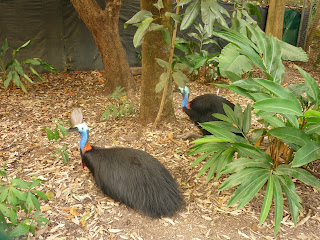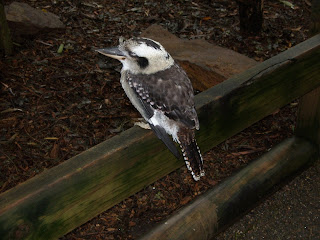Are you are bird lover?
If so you should go down under and check out the great Australian birds.
Australia is a vast country that has many different landscapes, climates and
environments. It is home to a host of
different wildlife species, many of which are totally unique and are not known
anywhere else in the world. But it is
not the fascinating and famous marsupial species such as the koala, kangaroo
and wombat, or the enigmatic monotremes such as the echidna and the duckbilled platypus
that we are going to be looking at, it is some of the Australia’s iconic bird
species. Australia’s bird species range
in size from the large, flightless emus and cassowaries to the tiny 9cm long
yellowy-green songbird called the Weebill.
Australia is home to magnificent birds of prey such as kites and
falcons, many parrot species, water fowl, song birds, owls and flightless
bird. The range of species is dazzling,
and wherever you are in Australia the birdsong can be heard and there are many
beautiful birds to be seen.
Emus
Emus are large flightless birds that are found across
Australia in a very diverse range of habitats, ranging from tropical woodland,
to inland grasslands, and coastal areas, but they do avoid very arid, desert
areas and heavily-populated areas. The
emu population is relatively stable and emus are not currently endangered. They
are one of the largest birds in the world, and emus are only slightly smaller
than ostriches. Emus have soft, brown
feathers and can stand as high as two metres tall. Emus are a nomadic species and can travel
long distances in search of food. Their
diet consists of grains, plants and insects.
 |
| Emus in Exmouth, Western Australia |
It is the male emus who incubates the eggs in the nest and
then raise the chicks. They can run at very high speeds of up to thirty miles
per hour. If you want to see emus in the
wild in Australia, one of the best places is Exmouth in Western Australia. In Exmouth, emus wander freely through the
streets and even wander into the grounds of hotels and into gardens. So make sure that you keep hold of your
lunch!
Cassowaries
Cassowaries are the other species of large flightless bird
that is found in Australia. Cassowaries
are an endangered species and can be found in the tropical rainforests of
Northern Queensland. There are only
thought to be only to be around 1500-3000 cassowaries left in Australia, with
around 40 individuals in captivity. The
decline in cassowary numbers is largely due to loss of habitat, but many
cassowaries are also killed in road accidents and in dog attacks. Feral pigs are also a big problem as the dig
out the cassowary nests and destroy their eggs as well as competing for food.
 |
| Cassowaries in Cairns Tropical Zoo |
Cassowaries are long-lived birds and can live for up to
fifty years. Cassowaries are mainly fruit eaters but will also eat snails,
fungi, frogs, flowers, birds, mice and carrion.
They have even been observed immersed in water fishing! Cassowaries play a very important part in the
life cycle of the rainforests and are a keystone species as they swallow seeds
and then later excrete them in other parts of the rainforest where they can
start growing. The cassowary is a very large and heavy bird, standing around
1.6 metres tall and weighing with blue and red skin on their head and necks and
a body covered with coarse black feathers.
They have strong legs with three-toed feet with sharp claws. Cassowaries have a spongy, horn-like crest
called casques on their heads. Cassowaries can be dangerous and have attacked
humans with those sharp claws. The
females are larger than the male cassowaries and lay three to six large pale
green eggs in the litter on the forest floor.
The male looks after the eggs and then guards the chicks as they grow
until they are about nine months old.
Kookaburras
Kookaburras are one of the most iconic of the Australian
birds. They are a large member of the
kingfisher family and are known as ‘laughing jackasses’ because of their
unmistakable call. In the outback the
call of the kookaburra is known as the ‘bushman’s clock’ as they start calling
as dawn breaks. Kookaburras have a
sturdy body, short neck and legs and a long, pointed beak. They stand about seventeen inches tall and
have dark brown, white and gray plumage.
Kookaburras live in woodland, more open grassland and have adapted very
well to living in residential areas. Kookaburras are carnivorous and eat
insects, mice small birds, lizards, and snakes. As kookaburras are so
comfortable around humans and are social birds they will hang around barbecues
and picnics accepting food or snatching it if they get the opportunity!
Kookaburras live in pairs and lay two to four whit eggs in tree hollows or
excavated termite hills. The young are
ready to leave the nest after thirty days and are fed by their parents for
another forty days.
 |
| Kookaburra |
Whistling Kites
Whistling kites patrol the roads of Australia looking for
road kill and circle the skies searching for prey. They can be found throughout Australia but tend
to prefer the warmer temperatures of the northern parts of the country. Whistling kites are carnivorous medium sized
raptors that capture its prey with its claws.
They have very good eyesight and can easily spot small mammals, lizards,
large insects, and birds from a great height.
It is said that during the frequent fires that occur in the bush that
the whistling kite will pick up a burning twig and drop it in another location
to start a new fire to flush out all the small creatures and insects that they
can eat.
.JPG) |
| Kites on the Adelaide River |
Whistling kites get their name from the whistling noise that
they make. They are either solitary
birds or live in pair, although occasionally a larger group will
congregate. They build large, messy
nests in large eucalyptus and pine trees where the female will incubate two to
three eggs. The chick will remain with
their parents for about six weeks, and a pair of whistling kites can breed up
to three times a year.
Pelicans
Australian pelicans are large water birds that have mainly
white plumage with black feathers on the edges of the wings. They have webbed feet, a wide wing-span and a
large beak that they use for fishing. They
have a saggy throat patch under their bills that they use to for collecting
food and when they are hot a pelican will flutter their throat pouches to try
and stay cool. `Pelicans prefer open stretches of water with little aquatic vegetation,
which has a large supply of fish for them to eat. Pelicans drive their prey into shallower
water and then thrust their beaks under the water in order to scoop up their
food. Pelicans build their nests in
shallow depressions in the sand or ground and they nest in colonies on islands
or isolated areas near to the coast or a lake.
Pelican usually lay two eggs and after the chicks are hatched the larger
one will usually get the lion’s share of the regurgitated fish that the parents
bring back and the smaller chick will usually eventually die of starvation or
be killed by its sibling. The remaining
chick will move on to eating whole fish and will be independent of their
parents in a couple of months.
.JPG) |
| Pelicans in Kalbarri, Western Australia |
No comments:
Post a Comment